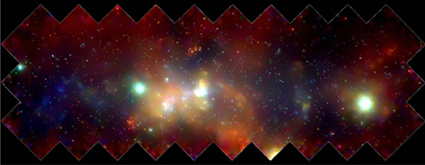January 9, 2002
RELEASE: 02-03
NASA's Chandra X-ray Observatory has made a stunning, high-energy panorama of the central regions of our Milky Way galaxy. The findings are an important step toward understanding the most active area of the Milky Way as well as other galaxies throughout the universe.
Like a sprawling megalopolis, the new Chandra images show hundreds of white dwarf stars, neutron stars and black holes bathed in an incandescent fog of multimillion-degree gas around a supermassive black hole.
"The center of the galaxy is where the action is," said Q. Daniel Wang of the University of Massachusetts, Amherst. "With these images, we get a new perspective of the interplay between stars, gas and dust, as well as the magnetic fields and gravity in the region. We can see how such forces affect the immediate vicinity and may influence other aspects of the galaxy."
Wang presented the montage of 30 separate Chandra images today at the American Astronomical Society meeting in Washington, and in a paper published in the Jan. 10, 2002, issue of the journal Nature. The images, made with the Advanced CCD Imaging Spectrometer (ACIS) July 16-21, 2001, covered a 400- by 900-light-year swath of the center of the galaxy.
One immediate result was that the team could separate out the individual X-ray sources from the diffuse glow produced by hot gas. "We can now see that the sources are responsible for most of the X-rays from highly ionized iron previously attributed to the diffuse glow," said Eric Gotthelf, of Columbia University in New York, a co-author. "So we must now revise our notion of the hot gas, which appears to be about 10 times cooler than previously thought. It's only a relatively mild 10 million degrees!"
The diffuse X-ray emission seems to be related to the turmoil and density of matter in the inner Milky Way. Stars are forming there at a much more rapid rate than in the galactic "suburbs." Many of the most massive stars in the galaxy are located in the galactic center and are furiously boiling off their outer layers in searing stellar winds. Supernova explosions are far more common in the region and send shock waves booming through the inner galaxy.
And then there is the three-million-solar-mass black hole at the epicenter. Although Chandra recently observed a small flare from the vicinity of the central supermassive black hole, the power output near the black hole remains relatively low.
However, an unexplained fluorescence of iron atoms, observed by the team to be associated with molecular clouds a few hundred light years away, may indicate that the supermassive black hole was hundreds of times brighter in the past. Alternatively, the fluorescence could be due to high-energy particles called cosmic rays produced by supernovas or bygone eruptions from the supermassive black hole.
"The galactic center is dominated by very high pressures due to the hot gas component and the strong magnetic fields," said Cornelia Lang, also of the University of Massachusetts, and a co-author. "It's a nice place to visit with a telescope but I wouldn't want to live there."
The Chandra map shows that the high-pressure and high-temperature gas is apparently escaping from the center into the halo of the galaxy. "A galaxy is a sort of ecosystem, and the activity in the center can seriously affect the evolution of the galaxy as a whole," said Wang. "Astronomically, the center of the Milky Way is really in our backyard, and, therefore, provides an excellent laboratory to learn about the cores of other galaxies."
The ACIS instrument was developed for NASA by Pennsylvania State University, University Park, and Massachusetts Institute of Technology, Cambridge. NASA's Marshall Space Flight Center in Huntsville, Ala., manages the Chandra program, and TRW, Inc., Redondo Beach, Calif., is the prime contractor. The Smithsonian's Chandra X-ray Center controls science and flight operations from Cambridge, Mass.
MEDIA CONTACTS
Dolores Beasley
Headquarters, Washington, DC
Phone: 202-358-1753
Steve Roy
Marshall Space Flight Center, Huntsville, AL
Phone: 256-544-6535
Megan Watzke
Chandra X-ray Observatory Center, CfA, Cambridge, MA
Phone: 617-496-7998



